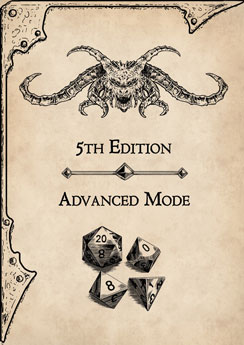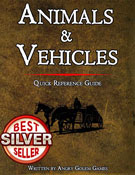Huge beast (dinosaur), unaligned
Armor Class 13 (natural armor)
Armor Class (suggested) 16 (front), 13 (flanks and rear)
Hit Points 95 (10d12 + 30)
Hit Points (suggested) 152 (16d12 + 30)
Speed 50 ft.
Proficiency Bonus +3
Proficiency Bonus +5 (5th Edition Advanced Mode)
| STR | DEX | CON | INT | WIS | CHA |
|---|---|---|---|---|---|
| 22 (+6) | 9 (-1) | 17 (+3) | 2 (-4) | 11 (+0) | 5 (-3) |
Skills (suggested) Perception +3
Senses passive Perception 10
Languages –
Challenge 5 (1,800 XP)
Trampling Charge. If the triceratops moves at least 20 feet straight toward a creature and then hits it with a gore attack on the same turn, that target must succeed on a DC 13 Strength saving throw or be knocked prone. If the target is prone, the triceratops can make one stomp attack against it as a bonus action.
Trampling Charge (suggested). If the triceratops moves at least 20 feet straight toward a creature and then hits it with a gore attack on the same turn, that target must succeed on a DC 13 Strength saving throw or be knocked prone and suffer 19 (2d12+6) bludgeoning damage. If the target is prone, the triceratops can make one stomp attack against it as a bonus action.
ACTIONS
- Multiattack (suggested). The triceratops makes three attacks, two with its gore and one stomp attack.
- Gore. Melee Weapon Attack: +9 to hit, reach 5 ft., one target. Hit: 24 (4d8 + 6) piercing damage.
- Gore (suggested). Melee Weapon Attack: +9 to hit, reach 5 ft., one target. Hit: 12 (1d12 + 6) piercing damage.
- Stomp. Melee Weapon Attack: +9 to hit, reach 5 ft., one prone creature. Hit: 22 (3d10 + 6) bludgeoning damage
5th Edition Advanced Mode
Limiting the power of a character and making the overall difficulty of the game harder, does not reduce the creativity, indeed it does quite the opposite.
The Game Master has the option to use any and all of the instances proposed in this guide, or just some of them according to their preference.
It is the lack of something that move and motivate characters, not the abundance of it
DESCRIPTION
The triceratops is a huge, herbivorous dinosaur with a massive skull and three horns. Its name means “three-horned face” in Greek. It has a short neck, a sturdy body, and four thick legs. Its tail is long and pointed, and its skin is covered with scales and bony plates. The triceratops is one of the most recognizable and popular dinosaurs, both in fiction and in reality.
COMBAT
The triceratops is not a very intelligent creature, but it is very aggressive and territorial. It will charge at any perceived threat, using its horns and weight to gore and trample its enemies. It can also stomp on prone foes with its powerful feet. The triceratops has a natural armor that protects it from most attacks, but it is vulnerable to fire and acid. The triceratops is not very fast, but it can cover a lot of ground with its long strides. It can also use its tail as a weapon, but it prefers to face its opponents head-on.
HABITAT / SOCIETY
The triceratops lives in grasslands, plains, and forests, where it can find plenty of plants to eat. It is a social animal, and usually travels in herds of up to 20 individuals. The triceratops communicates with low grunts and bellows, and uses its horns to signal its mood and status. The triceratops is loyal to its herd, and will defend it from predators and rivals. The triceratops has a simple hierarchy, with the largest and strongest male as the leader. The leader decides where the herd goes, and settles disputes among the members. The leader also has the right to mate with any female in the herd.
ECOLOGY
The triceratops is an important part of the ecosystem, as it helps to spread seeds and fertilize the soil with its dung. It also provides food for many carnivorous creatures, such as tyrannosaurs, allosaurs, and dragons. The triceratops has few natural enemies, but it is hunted by humans and other intelligent races for its horns, hide, meat, and bones. The triceratops is revered by some cultures as a symbol of strength, courage, and endurance.
Triceratops can be used as mounts or pulling animals for vehicles.
The statistics are detailed in the D&D 5e Animals & Vehicles reference guide. Just have a look at the preview on DrivethruRpg.

